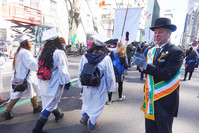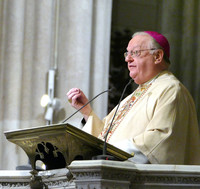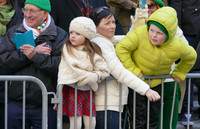



St. Patrick’s Day in New York began, as always, on Fifth Avenue, but not with a parade. That came later, and it was as heart-stirring as ever. The celebration opened early in the morning with the traditional Mass in St. Patrick’s Cathedral, where the emphasis was on the spiritual legacy of St. Patrick and the example he set for bringing the light of Christ to the world.
Cardinal Dolan, the principal celebrant, offered an enthusiastic “Fáilte” (“Welcome!”) to all, and added, “A blessed St. Patrick’s Day to everybody!” He greeted American and Irish dignitaries, including the parade grand marshal, philanthropist Loretta Brennan Glucksman, and “our legendary Fighting 69th,” soldiers of the 69th Regiment of New York, who marched into the cathedral and later led the parade up Fifth Avenue.
Laughter rang out when the cardinal added, “A warm welcome to our many civic leaders who are here today. We’re very happy to see you—in church!”
This year’s parade was dedicated to Catholic education and to the 20th anniversary of the Good Friday Agreement in Northern Ireland. Among the aides to the grand marshal was Dr. Timothy J. McNiff, superintendent of schools in the Archdiocese of New York.
Cardinal Dolan spoke about the significance of the day.
“Yes, we celebrate family and culture, and there’s going to be a lot of music and dancing and good fun,” he said. “But we’re especially about faith…the deep Catholic faith brought to Ireland by our beloved St. Patrick 16 centuries ago, and then brought here, to New York, by his spiritual sons and daughters.
“It’s the feast of our archdiocese, the feast of this towering cathedral,” he said.
The homilist was Bishop Dennis J. Sullivan of the Diocese of Camden, N.J. Born in the Bronx, and a former auxiliary bishop and vicar general of the New York Archdiocese, the bishop has worked extensively in the Hispanic community. He served for 20 years as pastor of St. Teresa’s parish in Manhattan, where he ministered to Chinese immigrants.
Bishop Sullivan said that from his earliest days he has known that his identity is “American Irish.”
“St. Patrick’s Day is certainly a day to celebrate with pride our American-Irish identity,” he said, but he also spoke of immigrants from many backgrounds.
“This cathedral is a statement in stone of the presence of the immigrant Church in this city,” the bishop said. “Early on they were Irish Catholics, but today (they are) an immigrant presence in our Church that has many skin colors, varieties of languages and cultural expressions, but who confess the same faith in Jesus Christ and have membership in the same Church as did the Irish-Catholic immigrants whose national Apostle is honored in this cathedral.”
He added, “Our Catholic Church throughout the country and very much in this archdiocese continues to welcome immigrants, and of that aren’t we descendants of immigrants very, very proud?”
Bishop Sullivan noted that St. Patrick “did not seek to change the culture of the clans,” but instead used their own symbols and ways of thinking to draw them to Christianity. For example, he said, St. Patrick superimposed “the powerful pagan Irish symbol for the sun onto the cross of Christ so that the instrument of salvation would seem more naturally Irish—the Celtic cross.”
The bishop remarked that St. Patrick “also realized the importance of developing a native clergy and native bishops.” St. Patrick “imbibed Irish culture” so thoroughly that he learned the Irish language and translated the Bible into Irish.
“His sensitive ministry struck a responsive chord with the Irish people,” he said. “There was widespread turning to Christ. It is one of the most dramatic missions in all of Church history.”
Ms. Glucksman, the grand marshal, later told CNY that she was thinking of her ancestors and all “the great immigrants who came over here to help make this great country.”
She and her late husband, philanthropist Lewis Glucksman, were leaders in the founding in 1993 of Glucksman Ireland House, a center at New York University for Irish and Irish-American studies and culture. Ms. Glucksman is co-chair of the center’s advisory board. She told CNY that Irish culture is “as vibrant as it’s been for 16 centuries.”
“There’s great scholarship going on in many centers for Irish studies,” she said. “Young people are eager to study all the wonderful richness of our culture. It’s living and dynamic and spreading out to other ethnicities…We have a master’s program now at Glucksman Ireland House, and we can’t keep up with the demand. And it’s not just Irish people.” Asian and African-American students are signing up, she said.
Dr. McNiff, archdiocesan superintendent of schools and an aide to the grand marshal, told CNY that he was delighted that the schools were being honored.
“The Catholic schools are a tremendous partner for education in general in the City of New York,” he said. “And the heritage and tradition that we have—it’s so important that we take time and recognize these wonderful institutions.”
He emphasized the schools’ service to the poor, and said that Catholic schools excel particularly in inner cities and among immigrants. In New York, he said, 98 percent of Catholic school students graduate and go on to college, and most are immigrants or the children of immigrants. “We hold kids to high standards, and we’re consistent with that,” Dr. McNiff said. “There’s a faith formation that comes with their development and their growth. When you put those two together with the wonderful partnership that we have with our families, our parents—that’s a formula for success.”
During the Mass, Cardinal Dolan remarked that there was one person he had forgotten to introduce. He put an arm across the shoulders of a small altar boy and said, “My nephew, Patrick Robert Dolan. Later, Patrick traded his cassock and surplice for a warm jacket and viewed the parade with his dad, the cardinal’s brother Pat. Young Patrick told CNY that it was “cool” to be serving Mass for his uncle.
Viewing the parade in front of the cathedral was Rep. Peter King (R-NY).
“St. Patrick’s Day means so much,” he said. “It’s a great celebration of our faith, our ancestry, our ethnic pride. But it also shows the beauty of New York. Everyone comes together. So many people here are not Irish, are not Catholic. So many people from different races, and I think it all comes together.” He added, “It’s important to realize that there’s peace in Northern Ireland. In the 1990s, so many of the Irish leaders from Northern Ireland would actually come here for the parade. This was really part of the peace process.”
Cardinal Dolan stood in front of the cathedral, waving and greeting marchers and dignitaries. Later, he told CNY, “There’s a great spirit of unity and gratitude and pride, isn’t there? Obviously, you feel great about being an Irishman, but to be an American, where all this can happen—I don’t know where else in the world you could celebrate such ethnic diversity and religious freedom.”